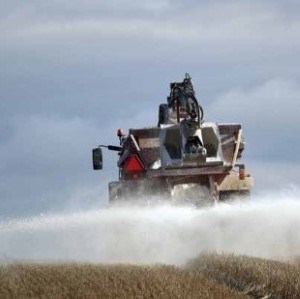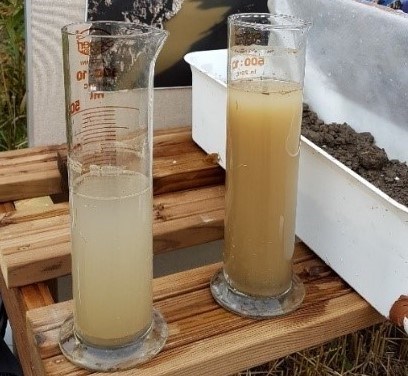Gypsum as soil amendment

Application of gypsum in agricultural soils is a common water protection measure in Finland for reducing phosphorus losses and erosion in clayey fields.
Gypsum (CaSO4+2H2O) reduces erosion, particulate phosphorus (PP) and dissolved reactive phosphorus (DRP) leaching from clay fields. Also leaching of organic carbon may decrease. Gypsum occurs in nature as a mineral which can be mined, but in Finland, large amounts of gypsum is available as a by-product of the phosphoric acid industry. After spreading gypsum is dissolved relatively quickly as calcium and sulfate ions and therefore the ionic strenght of soil pore water increases. When ionic strenght increases more phosphorus binds into clay particles and DRP leaching is reduced. When soil particles get closer each other and form larger aggregates erosion is reduced. Calcium also forms bridges between soil particles. Therefore, the fields amended with gypsum are less sensitive to erosion. Gypsum has no impact on pH.
Localisation and implementation
Gypsum is spread in clay fields with lime or manure spreader. Suggested amount is 4 t/ha of gypsum to achieve effective phosphorus load reduction. Gypsum should be spread after the harvest and before tilling. It is suitable for ploughing, reduced tillage and no-till farming. No-till sowing should not be carried out directly after gypsum spreading. The sulfate losses form a potentially adverse side effect of gypsum. Thus it is not recommended to spread it in groundwater formation areas and lake catchments. The impact of sulfate on the internal load in the lakes should be more closely investigated. Gypsum has also been found to impair the absorption of selenium by plants during the first year after spreading.
Effects, duration and maintenance
Gypsum reduces effectively erosion, phosphorus and organic carbon leaching from clay fields. The impact has been detected to last for five years. With gypsum amendment, the phosphorus load flowing into the Baltic Sea can be reduced immediately and cost effectively. Method is also easy to apply by farmers. Research data on long-term effects and impacts on other soils than clay are still needed.

Gypsum - extended description
Phosphorous loading from agricultural fields is the largest threat to water quality and marine living resources in the catchment of the Baltic Sea. Gypsum has proved to be an effective water protection measure for reducing phosphorus load and erosion in clayey fields. It is easy to apply method for farmers and the positive impacts are quickly visible. Particulate and dissolved phosphorus may be reduced immediately and cost effectively.
Description
Gypsum (CaSO4+2H2O) has long been known to improve soil structure in fields but its ability to bind phosphorus and reduce erosion has been recognised quite recently (Ekholm et. al 2012). Gypsum reduces erosion, particulate phosphorus (PP) and dissolved reactive phosphorus (DRP) leaching especially from clay fields. Also leaching of organic carbon may decrease.
Gypsum occurs in nature as a mineral which can be mined, but in Finland, large amounts of gypsum is available as a by-product of the phosphoric acid industry. When phosphorus acid is dissolved from appatite mineral in sulphuric acid a crystalline gypsum is formed. This so called phosphogypsum doesn’t include any heavy metals or other harmful substances and can therefore be used as a field amendment. Gypsum from flue-gas desulfurization is one potential source too.
After spreading gypsum is dissolved relatively quickly as calcium and sulfate ions and therefore the ionic strenght of soil pore water increases.
When ionic strenght increases more phosphorus binds into clay particles and DRP leaching is reduced. However, P remains available to plants to as high extent as before. When soil particles get closer each other and form larger aggregates erosion is reduced. Calcium also forms bridges between soil particles. Gypsum prevents soil particles from detaching during rainfall events and being lost in surface water runoff. Therefore, the fields amended with gypsum are less sensitive to erosion. This is also shown as clearer water from fields treated with gypsum (Figure 1). Unlike structure liming or other liming products normally used in agriculture gypsum has no impact on pH.

Localisation and implementation
Gypsum is spread in clay fields with lime or manure spreader. Suggested amount is 4 t/ha of gypsum to achieve effective phosphorus load reduction. Gypsum should be spread after the harvest and before tilling. It is suitable for ploughing, reduced tillage and no-till farming. No-till sowing should not be carried out directly after gypsum spreading. In a gypsum application pilot carried out in 2016 in Finland 55 farmers ordered gypsum through a local agricultural dealer. The majority (80% of the farms) of the application works were carried out by an external contractor, and the rest with the farm’s own equipment. After gypsum treatment reduced tillage were used in 58% of the fields and 33% were ploughed. Nine out of ten farmers assessed that the different stages of gypsum application process – delivery, storage and transfer of gypsum within the farm, as well as the application itself – went well. More than 70% of the farmers considered that method was well suited in between the other fieldworks (SAVE project).
The sulfate losses form a potentially adverse side effect of gypsum. When applying large amounts of gypsum in catchments with lakes, increased sulphate leaching may deteriorate fresh-water systems. Sulfate may lower ability of water bodies to retain phosphorus. Thus it is not recommended to spread it in lake catchments. The impact of sulfate on the internal load in the lakes should be more closely investigated.
Because the sulfate and calcium contained in gypsum easily runs off with water, it can also end up in groundwater after being filtered through soil strata. Gypsum is not therefore recommended for use in groundwater formation areas, although moderate concentrations of sulfate or calcium are not harmful to humans.
Gypsum is also not recommended for use on acid sulphate soils, as they have little effect on P leaching there. When ending up in the sea, SO4 causes no harm as seawater is naturally high in SO4.
Sulfate doesn’t bind into soil particles, but some calcium remains in the cation exchange sites, displacing especially magnesium and potassium from the particle surfaces. Gypsum has also been found to impair the absorption of selenium by plants during the first year after spreading.
In Finland, it has been estimated that potentially suitable area for the application of gypsum in the catchments of the Bothnian Sea, the Archipelago Sea and the Gulf of Finland is about 540 000 hectares, which is about a quarter of Finland’s entire field area. This estimate was made by delimiting areas for which gypsum treatment is not recommended due to e.g. the SO4 contained in the gypsum. In Gypsum Initiative project the potential of gypsum to reduce phosphorus load from agriculture in the entire Baltic Sea catchment was estimated to be even up to 25 %.
Effects, duration and maintenance
Gypsum reduces effectively erosion, phosphorus and organic carbon leaching from clay fields. First studies in Finland conducted in laboratory showed 70 % lower particulate phosphorus and 50 % lower dissolved phosphorus concentrations after rainfall simulation. Also dissolved reactive phosphorus was reduced by 35 % (Uusitalo et. al 2012). Iho & Laukkanen (2012) suggested that gypsum amendment as a means to reduce PP and DP loads from arable areas is economically best suited for fields with above average slope and phosphorus content. The impact has been detected to last for five years.
With gypsum amendment, the phosphorus load flowing into the Baltic Sea can be reduced immediately and cost eccectively. Method is also easy to apply by farmers. Research data on long-term effects and impacts on other soils than clay are still needed.
In the river Vantaa project gypsum was spread over 3 500 hectars of fields in southern Finland. In this large scale project also the effects of gypsum treatment on early life stage of trout was investigated. Gypsum was not found to affect reproduction of trout in the river.
Costs and policy instruments
In a large-scale pilot in 2016 gypsum was transported from eastern Finland to southwestern Finland (about 500 km) by 144 truck loads. The total cost of gypsum amendment was 220 euros per hectare. In reducing phosphorus load from agriculture, the cost was 60–70 euros per kilo of P – significantly less than costs of other currently available measures (SAVE project 2016).
Gypsum - links to resources
Pamphlets, reports, videos and websites
Video: The River Vantaa gypsum project
Project website: SAVE-project
Project website: The gypsum initiative
Scientific papers
Ekholm, P., Valkama, P., Jaakkola, E., Kiirikki M., Lahti K. & Pietola L. 2012. Gypsum amendment of soils reduces phosphorus losses in an agricultural catchment. Agricultural and Food Science 21: 279–291.
Iho A, Laukkanen M. 2012. Gypsum amendment as a means to reduce agricultural phosphorus loading: an economic appraisal. Agricultural and Food Science 21:307–324.
Uusitalo, R., Ylivainio, K., Hyväluoma, J., Rasa, K., Kaseva, J., Nylund, P., Pietola, L. & Turtola, E. 2012. The effects of gypsum on the transfer of phosphorus and other nutrients through clay soil monoliths Agricultural and Food Science 21: 260-278.
Author and contact:
Pasi Valkama, Finnish Environment Institute (SYKE), Finland. e-mail

